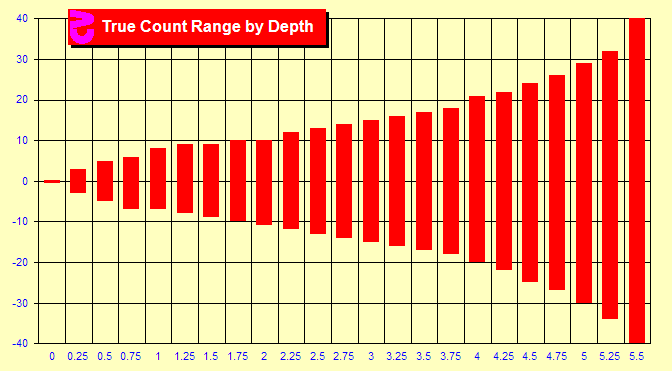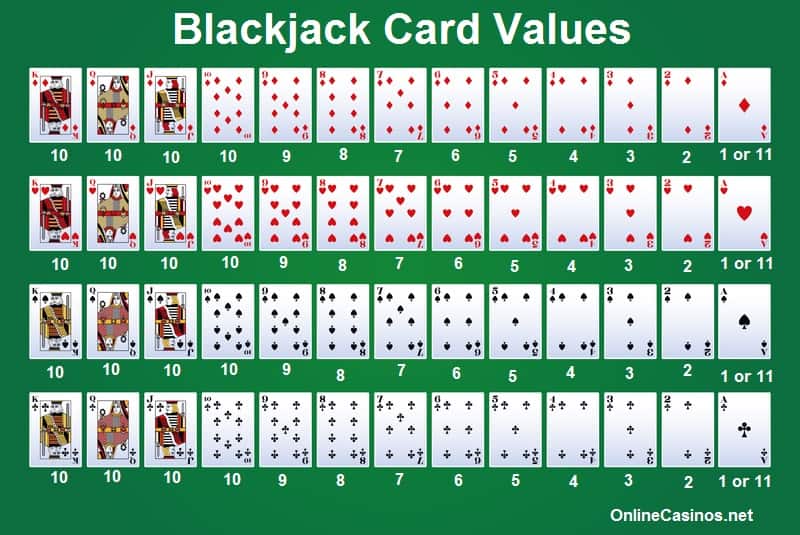Card Values In Blackjack
Blackjack: Who Wins?
If the dealer’s total (without going over 21) exceeds the player’s total, the dealer (or the casino, if you prefer) wins. If the player had bet $10 on the hand, the player loses $10. If both the player’s total and the dealer’s total are the same, it’s a tie, called a ‘”push” in casino lingo, and the player’s bet is returned.
Blackjack card values: All cards count their face value in blackjack. Picture cards count as 10 and the ace can count as either 1 or 11. Card suits have no meaning in blackjack. The total of any hand is the sum of the card values in the hand. Players must decide. Many misguided blackjack players would recommend others to always assume the dealer’s hole card has a value of 10. However, one such assumption is utter rubbish from a probability perspective. This “tactic” fails to accomplish everything else but an increase in the house edge. A two card hand is said to be 'blackjack' if it consists of an Ace and any card worth 10 (i.e. A ten, or a face card). Scoring function Next, we write a function that accepts a list containing the cards of the hand as tuples in the form (rank, suit).
However, if both the player and dealer go over 21, or ‘”bust” as it’s known in casino lingo, it’s not a “push” but a loss for the player.
That’s probably the most unfair rule there is in blackjack, but it’s one of the ways a casino maintains its advantage or winning edge over the players, and stays in business.
Other Decisions in Blackjack
In addition to deciding on every hand whether to “hit” or “stand,” a blackjack player will occasionally have to make other decisions during the course of play. Those decisions include doubling down, splitting pairs, taking insurance and surrendering.
Doubling Down
When you double down, you are allowed to double your bet after receiving your first two cards. You then receive one card only on your hand. Some casinos will allow you to double down on any two cards and some casinos limit your doubling to hands that total ten or eleven.
Splitting Pairs
If you are dealt a pair—two cards of the same value—you can split these into two separate hands. You must make an additional bet equal to your starting bet, and then you play each hand one at a time.
The dealer will give you a second card to go with the first split card, and you decide to hit or stand. After you play out this hand and stand you will move on to the next split card and the process will be repeated.
Insurance in Blackjack
If the dealer’s up card is an ace, the dealer will offer insurance, which is a side bet you make wagering half your original bet that the dealer has a ten-count card in the hole (hidden).
If you make the bet and he has the ten you are paid 2 to 1, but you would then lose your original bet but win the insurance bet, which works out to being a push of your original bet.
Face Card Values In Blackjack
If you have a blackjack and the dealer has an ace you will be asked if you would like even money for your blackjack instead of 3 to 2. If you do not take the even money, you will have a push if the dealer has a blackjack.
Both the insurance and the even money bet are sucker bets, as the dealers won’t have a ten-count in the hole more times than they will have a one-count. Basic Blackjack strategy tells you not to take these bets.
Surrendering in Blackjack
Some casinos will allow you to surrender your hand and give up half your bet on your first two cards after the dealer checks for a blackjack, and it is to the player’s advantage when played correctly. Unfortunately, though, when it is offered many players surrender more hands than they should, thus giving up the advantage gained by this option.
Article by Tom Somach
In order to understand how the best strategy is computed, lets have a look at the Blackjack rules. Blackjack is played with 1 to 9 decks of 52 cards each. The values of the cards correspond to their numerical value from 2-10. All face cards (Jack, Queen, King) count 10 and the Ace either 1 or 11, as the holders desires. A score with an ace valued as 11 is named soft-hand. A soft-hand score of 17 is denoted as 7/17.

The color of the cards does not have any effect.
The goal of the game is to reach a score (=sum of the cards) as high as possible but not more than 21. A Blackjack (Ace and a card whose value is 10) beats all other combination of cards. If the final sum is higher than the sum of the dealer, the player gets a play-off of 1:1 of his initial stake. If the players combination is Blackjack, the play-off is 3:2 of the initial stake. If the sum of the dealer is higher, the player loses his bet. If the sum is equal, then nobody wins. If the player holds a score of 22 or more, he busted and thus he loses his bet immediately. If the dealer busts, the players wins independently of his final score.
Blackjack can be played from one to seven players against one dealer. The dealer shuffles the cards. Now all the players must place their bets. Then each player and the dealer receives one card. The cards all lie face up. Thereafter the player receive a second card. The player now can continue to buy further cards, one by one, until he believes that he is near enough to 21. If the player believes to have reached a score high enough he must signalize the dealer to stay, which means not to ask for any further card.
Doubling down
Counting Cards In Blackjack Strategy
The player has some more possibility's other than buy and stay. If he reached a score of nine, ten or eleven with his first two cards, he can double his bet. However if he does so, he will be dealt only one more card.
Splitting
If the first two cards are of the same value, the player has the possibility to split his hand, which means that each of the cards are used to start with a separate bet. For each split hand, an additional bet equal to the first is required. There is one exception: If the player splits two Aces, he receives only one more card and in such a case a score of 21 is not considered as Blackjack.
Dealers turn
Once the last player has decided to stay with his score, the dealer starts to draw a second card. If his result is reaching a score of 17 or more, he will deal himself no further cards. If the dealer has a score of 16 or less, he must draw until he has reached 17 or more. If the dealer exceeds 21, he busts. This is the basic knowledge You have: The dealer can not split nor double; he must play according to strict rules: Dealer must stand on all 17. That's the players advantage! On the other side, if both the player and the dealer busts, these scores are not considered as equal and the player looses his stake. That's the dealers advantage!
Blackjack Card Numbers
How to compute the correct strategy
The analyst sees the shoe as black box which computes him a probability for drawing a card of a certain value. Say we have 6 decks of 52 cards, so the probability of drawing an Ace is 6*4/6*52 = 24/312 = 7.7%. The probability of drawing a second Ace without reshuffle is 23/311 = 7.4% and so on. As the game goes on without reshuffle, the probabilities to draw certain cards will raise or decline, depending on which cards have gone in the past. From our point of view the shoe behaves like a wheel of fortune with varying distances between the nails.
The first thing to do, is to calculate the probabilities of the dealers last hand. This computation is straight forward as the dealer has no way of doing any decision. So it is quit easy to find out the probabilities of his final score.
The next thing is to find out the probabilities of what would be if ... . If the players score is 16, what's the probability of achieving 17, 18, 19, 20, 21 or busting. Probabilities also have to be calculated for splitting and doubling.
Because the player knows the dealers first hand before deciding what to do, he can compare the probabilities of the dealers last hand against the probabilities of possible final scores for each intermediate score he has. With this comparison, winning expectations can be calculated, gaining information about the best playing strategy.
Knowing the best playing strategy and knowing the probabilities for each final score, the dealer and the player will reach, the total expectation can be calculated. The total expectation is the magic number playing Blackjack. If it is below zero the player has to place minimum bets as with this card distribution he will lose on the long term. If however the total expectation is above zero (unfortunately thats quite rare) the player has to place high bets.
Interpret the strategy tables
For each decision a player can do the best strategy can be computed. There are 20 possible conditions where the player has to take decisions. These are:
- Buy or stay if the score is 12, 13, 14, 15, 16, 7/17 or 8/18.
- Double or buy, if the sum of the first two cards is 9, 10 or 11.
- Split, buy or stay, if the first two cards have the same value.
All these decisions depend upon the dealers first card, making a total of 200. There are some fundamental rules, which never change and must always be obeyed:
- Alway buy if the score is below 12.
- Always buy if the score is below or equal to 7/17. With a soft hand You can't bust, so there is no reason to stay if the score is 17 or less.
- Never buy if the score is 17 or higher.
- Never split 5-5. A score of 10 is a good point to start with, so use it.
- Never split X-X. A score of 20 is too good, to take any further risks.
- Never ever double a Blackjack.
For other decisions consult the expectation and probability tables computed on the Blackjack strategy pages.

Stakes height
The stake has to be placed before the player can see the dealers first card. So during that decision, very little information is available. The only information the player here, is the total expectation for the current card distribution in the shoe. If this is above zero, he shall place high bets.